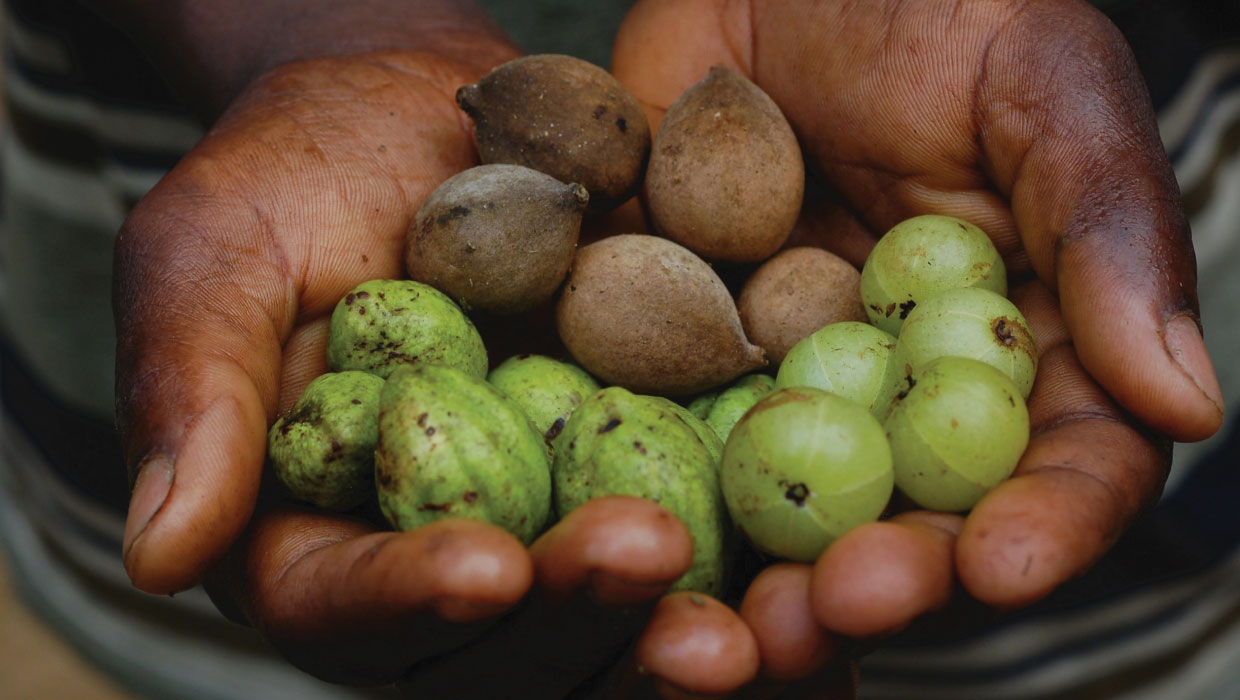Triphala translated, means three fruits- the most popular medicinal trio in Ayurveda. One could even start calling them as superheroes of the Ayurveda world! Haritaki (Terminalia chebula), Vibhitaki(Terminalia bellarica) and Amalaki(Phyllanthus embelica) are the three individual fruits which collectively are called Triphala; “Tri”- three, “Phala” – Fruits. Like any group of superheroes (an Avengers reference might be appropriate here), each of the ingredients has a specific role to play and has a life of its own. When they do come together, their actions are multifold, and they complement each other to provide the best effect desired. Seems rather ordinary? What makes them special and why do I call them superheroes?
Commonly found in many Ayurvedic formulations, let’s try to understand what makes this combination so special and how it can benefit you.

Individual roles of Haritaki, Vibhitaki and Amalaki
Haritaki- Fruit of the Terminalia chebula tree, Haritaki is one amongst the Triphala. It is synonymously referred to as Pathya (good for health), and it has many roles.
To taste, it dominantly tastes astringent and is composed of all other tastes except salty.
It shows Laghu (light) and Ruksha (dry) gunas, Ushna Virya (hot potency) ,it is Tridoshic in nature i.e. balances all three doshas which are Vata, Pitta and Kapha doshas and hence balances and uplifts overall health.
The most important role of Haritaki is in digestive health. Being a mild laxative, it is used widely in powder and ghee form to relieve mild constipation. However, being drying in nature, it should be used for shorter periods of time only.
Vibhitaki- the fruit of the Terminalia bellarica tree, Vibhitaki is another component of Triphala. Interestingly, it is synonymously known as “Akshaphala”, which means the seeds are used as dice in gambling.
Vibhitaki is primarily astringent in taste and helps in alleviating kapha and pitta doshas in the body. It is used for diseases above the neck primarily. It is very beneficial in diseases of the eye and exquisitely used in hair care. Oils processed with vibhitaki used regularly on hair promotes hair growth.
Amalaki- Fruit of Phyllanthus embelicus tree, Amalaki is the third component of Triphala. As its name suggests, it is “amla” i.e sour in taste. It is very popular for its rejuvenating properties and is often used daily as a Rasayana.
Primarily it tastes sour but has all other tastes except salty. Its properties are similar to that of Hritaki except that the potency of Amalaki is cold in nature. Having said this, it is helpful in balancing all the three doshas of the body.
Triphala as a combination
When the term “Triphala” is used, it is not to be understood that the combination is made up of one fruit each and instead to be understood that the combination should be weight wise equal portions of all the three fruits. This is because all three of them vary in size and shape and consequently, weight. This confusion does not exist when you get a premade Triphala powder mix but is of consequence when you are making your own powder mix.
Triphala as a combination, is helpful in reducing Kapha and pitta doshas in the body and is extensively used as a rasayana. It is available in many forms- powder, tablets, capsules, in medicated ghee and oil, as a decoction and even as extract. If one has access to Triphala powder, most forms are easy and can be prepared at home. Let’s find out a few common uses of Triphala.
Triphala for eyes
A decoction made by boiling triphala in water, straining it with a fine muslin cloth is useful as an eye wash or poured over the eyes. Fomentation with warm decoction using a soft cloth over closed eyes helps in reducing puffiness and It helps in restoring the beauty of eyes keeping them bright and energised. Care needs to be taken to strain the decoction well before using.
Triphala for hair and skin
Powder of triphala, mixed with a suitable adjuvant based on skin type, when applied on the skin as a mask, helps in keeping it blemish free. Oil processed with powder of Triphala, can help in hair growth and strengthening the roots. It also yields a cooling sensation and makes hair lustrous and shiny.
Triphala for dental care
Triphala fruits were burnt in the open air to get ash. This ash has been extensively used since ages to clean teeth and massage the gums. Similar to charcoal toothpastes and powders, this helps in maintaining healthy teeth and gums.
Triphala for gut care
Triphala helps in cleansing the bowel and acts as a mild laxative, mainly due to Haritaki and Vibhitaki. It can be used in the powder or ghee form for this purpose. However, ghee form is better as using dry Triphala for longer periods can have a very drying effect on the body. Regular usage of this helps in cases of indigestion and sour belching after eating.
Triphala for wound care
Triphala taken internally helps in faster healing of wounds. Ash prepared with Triphala when used on minor cuts and wounds, helps to heal it faster.
Triphala as a Rasayana
A lot has been spoken about free radicals and antioxidants. All the Triphala are antioxidants and help the body by eliminating of free radicals. Amalaki, one of the components of Triphala, is a good source of Vitamin C as well. Due to the unique combination of these three fruits, each of which is equally powerful, it acts as a rejuvenator for the body. Triphala, used in various forms regularly can help in maintaining health and keep the body strong.

Things to remember while using Triphala
As powerful and potent it is, Triphala is to be used with caution and understanding your body type. A Prakriti analysis will help in giving you an idea about what is good for your body and what isn’t. An Ayurvedic practitioner can help you assess this in case of any ailments as well.
Given that most ingredients are Ruksha- drying in nature, it is important to remember that in the longer-term, Triphala is best when used with an adjuvant like ghee or in the form of a Rasayana like Chyavanaprasha.



